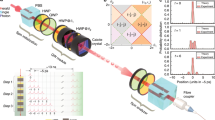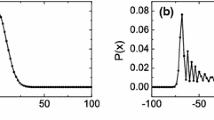Abstract
Discrete-time quantum walks are Floquet systems if the quantum walk operator is independent of time. We consider such one-dimensional quantum walks with two quantum coin operators arranged in discrete space according to periodic, Fibonacci quasiperiodic and random sequences. We explore the correlation dimension of Floquet quasienergy spectrum, Floquet level spacing ratio and inverse participation ratio of Floquet states, respectively. We find they increase with spreading exponent and surviving exponent, so the statistics of Floquet quasienergy is an effective quantity to reflect dynamical properties in quantum transport of discrete-time quantum walks. We also contrast the differences among the three kinds of quantum walks.
Graphic abstract





Similar content being viewed by others
Data Availability
This manuscript has no associated data or the data will not be deposited. [Authors’ comment: No external data, like from experiments, was collected in this study. All results are obtained directly from simulations and can be seen as they are in the figures.]
References
N. Masuda, M.A. Porter, R. Lambiotte, Random walks and diffusion on networks. Phys. Rep. 716, 1 (2017)
Y. Aharonov, L. Davidovich, N. Zagury, Quantum random walks. Phys. Rev. A 48, 1687 (1993)
J. Kempe, Quantum random walks–an introductory overview. Contemp. Phys. 44, 307 (2003)
S.E. Venegas-Andraca, Quantum walks: a comprehensive review. Quant. Inf. Process. 11, 1015 (2012)
D. Reitzner, D. Nagaj, V. Buz̆ek, Quantum walks. Acta Phys. Slovaca 61, 603 (2011)
O. Mülken, A. Blumen, Continuous-time quantum walks: models for coherent transport on complex networks. Phys. Rep. 502, 37 (2011)
X. Zhan, L. Xiao, Z. Bian, K. Wang, X. Qiu, B.C. Sanders, W. Yi, P. Xue, Detecting topological invariants in nonunitary discrete-time quantum walks. Phys. Rev. Lett. 119, 130501 (2017)
R. Portugal, Quantum walks and search algorithm (Springer, Berlin, 2013)
A. Aspuru-Guzik, P. Walther, Photonic quantum simulators. Nat. Phys. 8, 285 (2012)
E. Farhi, S. Gutmann, Quantum computation and decision trees. Phys. Rev. A 58, 915 (1998)
A. Ambainis, J. Kempe, A. Rivosh, Coins make quantum walks faster (SIAM, Philadelphia, 2005)
N. Lo Gullo, C.V. Ambarish, Th. Busch, L. Dell’Anna, C.M. Chandrashekar, Dynamics and energy spectra of aperiodic discrete-time quantum walks. Phys. Rev. E 96, 012111 (2017)
I. Vakulchyk, M.V. Fistul, P. Qin, S. Flach, Anderson localization in generalized discrete-time quantum walks. Phys. Rev. B 96, 144204 (2017)
S. Derevyanko, Anderson localization of a one-dimensional quantum walker. Sci. Rep. 8, 1795 (2018)
A.R.C. Buarque, W.S. Dias, Aperiodic space-inhomogeneous quantum walks: Localization properties energy spectra, and enhancement of entanglement. Phys. Rev. E 100, 032106 (2019)
N. Linden, J. Sharam, Inhomogeneous quantum walks. Phys. Rev. A 80, 052327 (2009)
Y. Shikano, H. Katsura, Localization and fractality in inhomogeneous quantum walks with self-duality. Phys. Rev. E 82, 031122 (2010)
P. Ribeiro, P. Milman, R. Mosseri, Aperiodic quantum random walks. Phys. Rev. Lett. 93, 190503 (2004)
A. Geraldi, A. Laneve, L.D. Bonavena, L. Sansoni, J. Ferraz, A. Fratalocchi, F. Sciarrino, Á. Cuevas, P. Mataloni, Experimental investigation of superdiffusion via coherent disordered quantum walks. Phys. Rev. Lett. 123, 140501 (2019)
B. Danacı, İ Yalçınkaya, Çakmak, G. Karpat, S.P. Kelly, A.L. Subaşı, Disorder-free localization in quantum walks. Phys. Rev. A 103, 022416 (2021)
G. Martín-Vázquez, J. Rodríguez-Laguna, Optimizing the spatial spread of a quantum walk. Phys. Rev. A 102, 022223 (2020)
M. Malishava, I. Vakulchyk, M. Fistul, S. Flach, Floquet Anderson localization of two interacting discrete time quantum walks. Phys. Rev. B 101, 144201 (2020)
J.K. Asbóth, A. Mallick, Topological delocalization in the completely disordered two-dimensional quantum walk. Phys. Rev. B 102, 224202 (2020)
H. Sambe, Steady states and quasienergies of a quantum-mechanical system in an oscillating field. Phys. Rev. A 7, 2203 (1973)
J.H. Shirley, Solution of Schrödinger equation with a Hamiltonian periodic in time. Phys. Rev. 138, B979 (1965)
T. Groh, S. Brakhane, W. Alt, D. Meschede, J.K. Asbóth, A. Alberti, Robustness of topologically protected edge states in quantum walk experiments with neutral atoms. Phys. Rev. A 94, 013620 (2016)
A. Bisianov, A. Muniz, U. Peschel, O.A. Egorov, Topological Floquet interface states in optical fiber loops. Phys. Rev. A 102, 053511 (2020)
L. Xiao, TSh. Deng, K.K. Wang, Zh. Wang, W. Yi, P. Xue, Observation of Non-Bloch Parity–Time symmetry and exceptional points. Phys. Rev. Lett. 126, 230402 (2021)
D.W. Hone, M. Holthaus, Locally disordered lattices in strong ac electric fields. Phys. Rev. B 48, 15123 (1993)
M. Holthaus, G.H. Ristow, D.W. Hone, ac-field-controlled anderson localization in disordered semiconductor superlattices. Phys. Rev. Lett. 75, 3914 (1995)
M. Holthaus, D.W. Hone, Localization effects in ac-driven tight-binding lattices. Philos. Mag. B 74, 105 (1996)
D.F. Martinez, R.A. Molina, Delocalization induced by low-frequency driving in disordered tight-binding lattices. Phys. Rev. B 73, 073104 (2006)
H. Hatami, C. Danieli, J.D. Bodyfelt, S. Flach, Quasiperiodic driving of Anderson localized waves in one dimension. Phys. Rev. E 93, 062205 (2016)
D.T. Liu, J.T. Chalker, V. Khemani, S.L. Sondhi, Mott, Floquet, and the response of periodically driven Anderson insulators. Phys. Rev. B 98, 214202 (2018)
V.A. Gopar, R.A. Molina, Controlling conductance statistics of quantum wires by driving ac fields. Phys. Rev. B 81, 195415 (2010)
T. Kitagawa, T. Oka, E. Demler, Photo control of transport properties in a disordered wire: average conductance, conductance statistics, and time-reversal symmetry. Ann. Phys. 327, 1868 (2012)
E. Benito-Matias, R.A. Molina, Localization length versus level repulsion in one-dimensional driven disordered quantum wires. Phys. Rev. B 96, 174202 (2017)
C. Ma, Y.-S. Wang, J.-H. An, Floquet engineering of localized propagation of light in a waveguide array. Phys. Rev. B 97, 023808 (2018)
V.M. Vyas, D. Roy, Topological aspects of periodically driven non-Hermitian Su–Schrieffer–Heeger model. Phys. Rev. B 103, 075441 (2021)
N.Y. Yao, A.C. Potter, I.-D. Potirniche, A. Vishwanath, Discrete time crystals: rigidity, criticality, and realizations. Phys. Rev. Lett. 118, 030401 (2017)
T.A. Brody, J. Flores, J.B. French, P.A. Mello, A. Pandey, S.S.M. Wong, Random-matrix physics: spectrum and strength fluctuations. Rev. Mod. Phys. 53, 385 (1981)
V. Oganesyan, D.A. Huse, Localization of interacting fermions at higher temperature. Phys. Rev. B 75, 155111 (2007)
S. Notarnicola, F. Iemini, D. Rossini, R. Fazio, A. Silva, A. Russomanno, From localization to anomalous diffusion in the dynamics of coupled kicked rotors. Phys. Rev. E 97, 022202 (2018)
M. Sarkar, R. Ghosh, A. Sen, K. Sengupta, Mobility edge and multifractality in a periodically driven Aubry–André model. Phys. Rev. B 103, 184309 (2021)
J. Wang, J.B. Gong, Butterfly floquet spectrum in Driven SU(2) systems. Phys. Rev. Lett. 102, 244102 (2009)
R.J. Sharma, T.G. Sarkar, J.N. Bandyopadhyay, Floquet analysis of a fractal-spectrum-generating periodically driven quantum system. Phys. Rev. E 98, 042217 (2018)
E.M. Barber, Aperiodic structures in condensed matter: fundamentals and applications (CRC Press, Boca Raton, 2009)
J. Fillman, D.C. Ong, Purely singular continuous spectrum for limit-periodic CMV operators with applications to quantum walks. J. Funct. Anal. 272, 5107 (2017)
A. Ambainis, E. Bach, A. Nayak, A. Vishwanath, J. Watrous, One-dimensional quantum walks. In: Proceedings of the 33th STOC, (ACM New York, 2001), pp. 37–49
D.R. Hofstadter, Energy levels and wave functions of Bloch electrons in rational and irrational magnetic fields. Phys. Rev. B 14, 2239 (1976)
I. Guarneri, Spectral properties of quantum diffusion on discrete lattices. Europhys. Lett. 10, 95 (1989)
F. Piéchon, Anomalous diffusion properties of wave packets on quasiperiodic chains. Phys. Rev. Lett. 76, 4372 (1996)
R. Ketzmerick, K. Kruse, S. Kraut, T. Geisel, What determines the spreading of a wave packet? Phys. Rev. Lett. 79, 1959 (1997)
M. Wilkinson, E.J. Austin, Spectral dimension and dynamics for Harper’s equation. Phys. Rev. B 50, 1420 (1994)
R.C. Hilborn, Chaos and nonlinear dynamics (Oxford University Press, New York, 1994)
Y.Y. Atas, E. Bogomolny, O. Giraud, G. Roux, Distribution of the ratio of consecutive level spacings in random matrix ensembles. Phys. Rev. Lett. 110, 084101 (2013)
E.J. Torres-Herrera, J.A. Méndez-Bermúdez, L.F. Santos, Level repulsion and dynamics in the finite one-dimensional Anderson model. Phys. Rev. E 100, 022142 (2019)
L.Y. Gong, K.X. Ma, Comparison of higher-order level spacing ratios signatures localization-delocalization transitions in one-dimensional single-electron lattice systems. Phys. Lett. A 384, 126298 (2020)
V.K.B. Kota, Embedded random matrix ensembles in quantum physics (Springer, Berlin, 2014)
M.V. Berry, M. Tabor, Level clustering in the regular spectrum. Proc. R. Soc. Lond. Ser. A 356, 375 (1977)
A. Pandey, R. Ramaswamy, Level spacings for harmonic-oscillator systems. Phys. Rev. A 43, 4237 (1991)
J.T. Edwards, D.J. Thouless, Numerical studies of localization in disordered systems. J. Phys. C 5, 807 (1972)
L.Y. Gong, H. Lu, W.W. Cheng, Exact Mobility edges in 1D mosaic lattices inlaid with slowly varying potentials. Adv. Theory Simul. 4, 2100135 (2021)
Y. Wang, X. Xia, L. Zhang, H. Yao, Sh. Chen, J. You, Q. Zhou, X.-J. Liu, One-dimensional quasiperiodic mosaic lattice with exact mobility edges. Phys. Rev. Lett. 125, 196604 (2020)
Acknowledgements
This work was supported by the National Natural Science Foundation of China (Grant No.61871234).
Author information
Authors and Affiliations
Contributions
All the authors were involved in the design and development of the present research, as well as in the manuscript preparation.
Corresponding author
Appendices
Appendix A: Correlation dimension in different system sizes
At different system sizes N, the dependence of correlation dimension \(D_c\) on \(\theta _2\) are given in Fig. 5. Here, we present \(D_c\) for periodic and Fibonacci DTQWs. For random DTQWs, the corresponding Floquet quasienergy spectrum is point spectrum [21] and the “pointwise” method to calculate \(D_c\) [55] can not properly determine its correlation dimension. Fig. 5 shows \(D_c\) decreases with N. The difference of \(D_c\) for different N is reduced as N increases, so we expect the values of \(D_c\) will eventually reach asymptotic ones at larger N.
Appendix B: Floquet level spacing ratio in different system sizes
At different system sizes N, the dependence of Floquet level spacing ratio \(\langle {r}\rangle \) on \(\theta _2\) are given in Fig. 6. For periodic DTQWs, Fig. 6a shows except at \(\theta _2=\pi /2\) and \(3\pi /2\) (states are localized), \(\langle {r}\rangle \) slightly increases with N and it approaches to ones for larger N, which reflects these states are extended [58]. For Fibonacci DTQWs, Fig. 6b shows \(\langle {r}\rangle \) may slightly decreases (\(0\le \theta _2<\pi /4\) and \(3\pi /4<\theta _2\le 2\pi \)) or slightly increases (\(\pi /4<\theta _2<3\pi /4\)) with N. As the spectrum is singular continuous ones, \(\langle {r}\rangle \) is sensitive to system size N. In contrast, for random DTQWs, Fig. 6c shows except at \(\theta _2=\pi /4\) and \(3\pi /4\) (states are extended), \(\langle {r}\rangle \) slightly decreases with N or almost does not change. And most values of \(\langle {r}\rangle \) is nearly equal to or less than 0.386, which means these states are localized [58].
Appendix C: Approximate fractal dimension in different system sizes
At different system sizes N, the dependence of approximate fractal dimension \(\varGamma \) on \(\theta _2\) are given in Fig. 7. It is known that \(\varGamma \rightarrow 1\) for extended states and \(\varGamma \rightarrow 0\) for localized states [64]. For periodic DTQWs, Fig. 7a shows \(\varGamma \) is relative large and it increases with N, which means these states are extended; at \(\theta _2=\pi /2\) and \(3\pi /2\), \(\varGamma \) is relative small though it slightly increases with N, and such states correspond to localized states. For Fibonacci DTQWs, Fig. 7b shows as \(\theta _2\) is apart from \(\pi /4\) and \(3\pi /4\), \(\varGamma \) is intermediate and the difference of \(\varGamma \) for different N almost disappears as N increases, which means these states are critical. The results for random DTQW are shown in Fig. 7c, where 500, 300 and 100 disorder realizations are applied for system sizes \(N=500, 1000\) and 2000, respectively. It shows except at \(\theta _2=\pi /4\) and \(3\pi /4\) (states are extended), \(\varGamma \) is relatively small and it decreases with N, which means these states are localized.
Rights and permissions
About this article
Cite this article
Gong, L., Sun, J., Guo, X. et al. Statistics of Floquet quasienergy spectrum for one-dimensional periodic, Fibonacci quasiperiodic and random discrete-time quantum walks. Eur. Phys. J. B 95, 78 (2022). https://doi.org/10.1140/epjb/s10051-022-00339-4
Received:
Accepted:
Published:
DOI: https://doi.org/10.1140/epjb/s10051-022-00339-4







